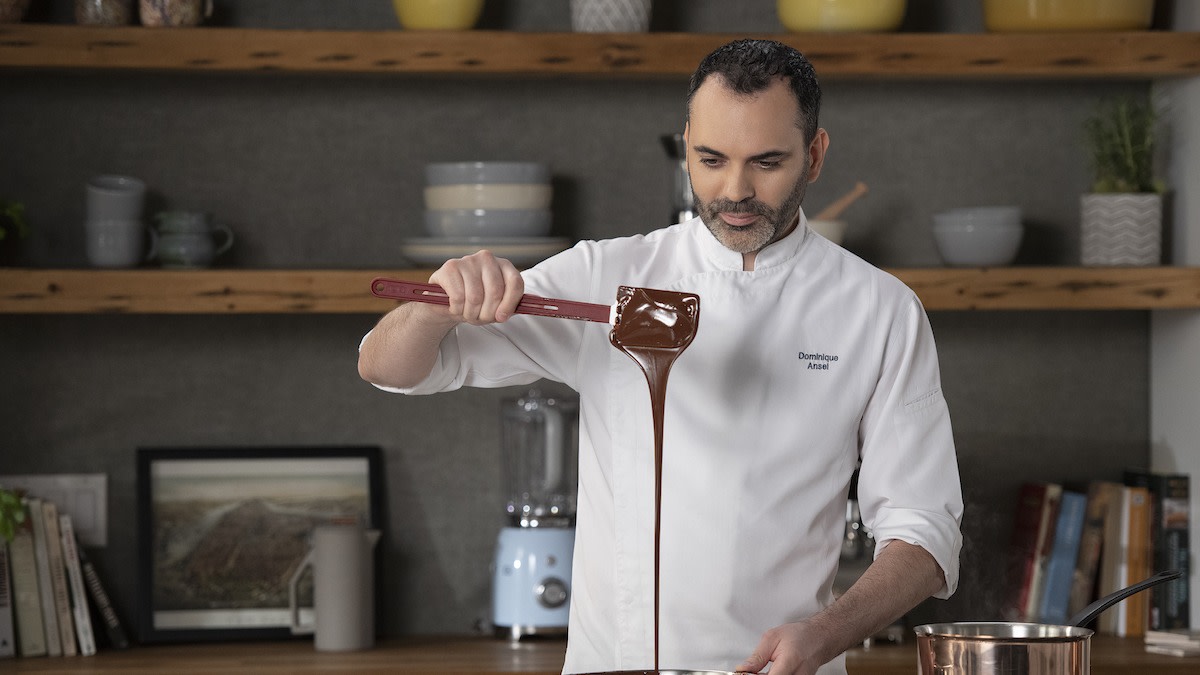Chef Dominique Ansel’s Tempered Chocolate Recipe
Written by MasterClass
Last updated: Nov 9, 2022 • 4 min read
Most confectionary techniques flirt with the line between chemistry and magic. Exhibit A: the shiny gloss of freshly tempered chocolate.
“The beauty of chocolate,” notes Chef Dominique Ansel, “is that you can build something beautiful with it, melt it down again, and give it new life.” When you melt, cool, then re-warm chocolate to a specific temperature, its fats—namely, cocoa butter— realign and crystalize in the ideal way to create a smooth, glossy finish and appetizingly snappy texture.
Untempered chocolate sets matte, often with white streaks of cocoa butter on the surface (this is called “bloom”) and crumbles rather than breaks evenly. Tempering chocolate also raises the melting temperature, making something like a truffle or bonbon less likely to melt on contact with your fingers.
Learn From the Best
What Is the Melting Point of Chocolate?
- Dark chocolate melts at 118°F (48–50°C)
- Milk chocolate melts at 113°F (45°C)
- White chocolate melts at 109°F (43°C)
5 Tips to Remember During the Tempering Process
There are two primary techniques to tempering chocolate: tabling and seeding. Regardless of which method you prefer, follow the tips below to ensure you temper chocolate evenly.
- 1. If you heat the temperature of the chocolate on its own to over 129°F (54°C), you will burn or scorch it. If using a double-boiler or a microwave to melt the chocolate, stop before it’s fully melted to avoid going too far. Any remaining chunks will melt as you stir.
- 2. Chocolate chips contain stabilizers and will not temper as a result.
- 3. If you wet the chocolate with water or steam while tempering it, the chocolate will seize and turn grainy and pasty. This often happens when condensation drips onto your work surface from under the bowl of melted chocolate, or when the work surface isn't completely dry before pouring the melted chocolate over it. Always thoroughly dry any surface or equipment that may come into contact with water to ensure it does not ruin your chocolate.
- 4. In your first few times tempering, always make sure to test by dipping an offset spatula or piece of parchment paper into the chocolate to see if it sets shiny. If not, try again with the same chocolate. Once tempered, chocolate must be used immediately. If it solidifies, re-temper.
- 5. White chocolate contains higher levels of milk and added sugar, making it much easier to burn, so keep an eye on it.
Chef Dominique Ansel's Tempered Chocolate Shell Recipe
makes
Ingredients
The delight of biting into a chocolate bonbon is related to both texture and taste—the clean snap of the outer shell gives way to the smooth, rich ganache filling inside, which you can flavor with any number of fruit purées, herbs, extracts, or spices.
Equipment:
If using the tabletop technique:
- 1
Start with a marble or granite surface, which is clean and dry and doesn’t absorb heat. The surface should be cool. If it’s not, or if the temperature in your work space is warm, lay a rimmed sheet pan on the marble then fill it with ice. Let the chilled sheet pan rest on the marble for 2 minutes to cool the marble.
- 2
Meanwhile, melt the chocolate to the proper temperature. Pour enough water into a medium saucepan to come 1 inch up the side, then bring to a simmer over medium-low heat. Place the chopped chocolate in a metal bowl, then set the bowl over the simmering water. Stir until the chocolate is fully melted and heated to the proper temperature.
- 3
When the chocolate is ready, remove the chilled sheet pan, if using, and wipe the marble surface completely dry. Remove the bowl from over the saucepan and wipe the bottom dry to prevent any condensation from dripping onto the marble surface. Pour 80 percent of the melted chocolate onto the marble and reserve the remaining chocolate in the bowl to the side. Using two bench scrapers, slowly move the chocolate from the center outward to the sides to make a rectangle. Continue scraping the chocolate from the sides inward and back out again; this is also referred to as “agitating the chocolate.” Scrape the bench scrapers against each other to clean them as you work.
- 4
Watch as the chocolate starts to thicken and develop a gleam. The temperature should be about 84°F (29°C), and the chocolate should feel slightly cool to the touch, as it’s just below body temperature.
- 5
Using the bench scrapers, return the agitated chocolate to the bowl with the remaining melted chocolate and stir gently to combine. The agitated chocolate will reheat slightly as the whole amount comes to the proper temperature. If it doesn’t, place the bowl of chocolate over the saucepan and stir continuously with a rubber spatula until the chocolate reaches the proper temperature, as indicated below:
Dark chocolate: 88°F (31°C)
Milk chocolate: 86°F (30°C)
White chocolate: 86°F (30°C)
If using the seeding technique:
- 1
Melt two-thirds of the chocolate that you want to temper.
- 2
Finely chop the remaining one-third. Slowly mix one-third of the chopped chocolate into the melted chocolate and stir with a rubber spatula until it’s fully melted.
- 3
Continue adding half the remaining chopped chocolate, stirring until melted, then stir in the remaining chopped chocolate. As you add the chopped chocolate and “seed” the melted chocolate, it will cool. The chocolate should be tempered to the proper temperature by the time all the chopped chocolate has been incorporated.
Become a better chef with the MasterClass Annual Membership. Gain access to exclusive video lessons taught by culinary masters, including Dominique Ansel, Gordon Ramsay, Alice Waters, and more.
